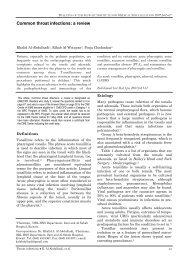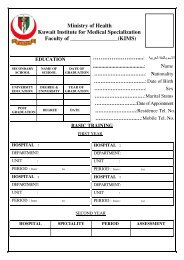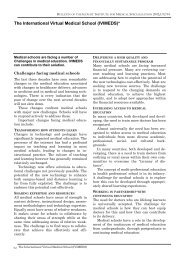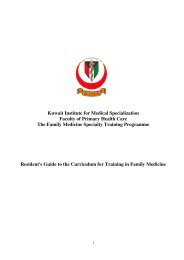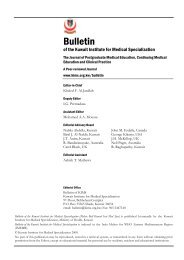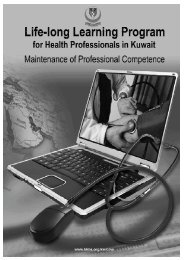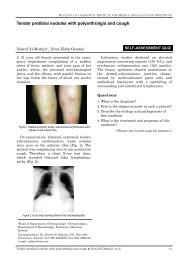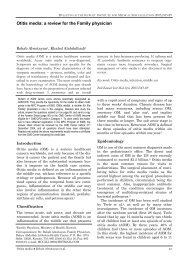Atopic dermatitis: an update review of clinical manifestations and ...
Atopic dermatitis: an update review of clinical manifestations and ...
Atopic dermatitis: an update review of clinical manifestations and ...
Create successful ePaper yourself
Turn your PDF publications into a flip-book with our unique Google optimized e-Paper software.
BULLETIN OF THE KUWAIT INSTITUTE FOR MEDICAL SPECIALIZATION 2007;6:55-62<br />
nappy area is usually spared. Scalp involvement<br />
may be severe enough to cause alopecia.<br />
12 In children aged 2 – 12 years the flexor<br />
surfaces, neck, wrists <strong>an</strong>d <strong>an</strong>kles are the usual<br />
sites. The lesion in teenagers <strong>an</strong>d young adults<br />
is a rash on the flexor areas <strong>of</strong> arms (<strong>an</strong>tecubital<br />
<strong>an</strong>d popliteal), legs, face (especially<br />
periorbital region) <strong>an</strong>d neck. The presence <strong>of</strong><br />
extensor distribution in older children <strong>an</strong>d<br />
adults indicates a poor prognosis for ultimate<br />
cure. 13 Axillary, groin <strong>an</strong>d intergluteal<br />
involvement is uncommon <strong>an</strong>d should raise<br />
suspicion <strong>of</strong> some other causative factor. The<br />
diagnostic features are shown in Table 1. For<br />
the diagnosis to be established at least 3 major<br />
features <strong>an</strong>d 3 minor features need to be<br />
present. 14 The differential diagnoses are listed<br />
in Table 2.<br />
Table 2. Differential diagnosis <strong>of</strong> atopic <strong>dermatitis</strong><br />
• Seborrheic <strong>dermatitis</strong><br />
• Psoriasis<br />
• Neuro<strong>dermatitis</strong><br />
• Contact <strong>dermatitis</strong><br />
• Ataxia-tel<strong>an</strong>giectasia syndrome<br />
• Histiocytosis –X<br />
• Lichen simplex chronicus<br />
• Photosensitivity rashes<br />
• Icthyosis vulgaris<br />
• Scabies<br />
• Dermatitis herpetiformis<br />
• Dermatophyte infection<br />
• Systemic illnesses such as malign<strong>an</strong>cies, thyroid disorders, hepatic or<br />
renal failure<br />
Laboratory Findings<br />
There are no specific laboratory findings or<br />
histologic features which c<strong>an</strong> be relied on for<br />
diagnosis, hence the import<strong>an</strong>ce <strong>of</strong> history <strong>an</strong>d<br />
physical examination. 7 Elevated IgE levels are<br />
found in up to 80% <strong>of</strong> affected patients, but<br />
this result may be observed in other atopic<br />
disorders as well. 15 Biopsy <strong>of</strong> skin shows a<br />
thickened <strong>an</strong>d hyperkeratotic dermis with<br />
perivascular inflammation. 2<br />
Care <strong>an</strong>d M<strong>an</strong>agement<br />
Prevention is the mainstay <strong>of</strong> treatment <strong>of</strong><br />
atopic <strong>dermatitis</strong>. This includes proper diagnosis,<br />
expl<strong>an</strong>ation <strong>an</strong>d patient education about<br />
the natural history <strong>of</strong> the disease, the different<br />
types <strong>of</strong> drugs <strong>an</strong>d the prognosis <strong>of</strong> the<br />
<strong>Atopic</strong> <strong>dermatitis</strong> ● S.T. Jamal<br />
condition. Given the chronic nature <strong>of</strong> the<br />
disease, emotional support <strong>an</strong>d psychological<br />
counseling may be helpful. Patients should be<br />
informed that no cure exists, but that exacerbations<br />
c<strong>an</strong> be minimized with optimal care.<br />
ADVICE ON TRIGGER FACTORS<br />
Patients <strong>an</strong>d their parents should know the<br />
common trigger factors <strong>an</strong>d try to avoid<br />
them. 12 The trigger factors include excessive<br />
bathing, h<strong>an</strong>d washing, lip lickering, sweating<br />
or swimming. Contact with solvents, deodor<strong>an</strong>ts,<br />
cosmetics <strong>an</strong>d exposure to sunlight as<br />
well as wearing loose or poorly fitting clothes<br />
that const<strong>an</strong>tly rub the skin c<strong>an</strong> exacerbate<br />
the disease. Prolonged heat exposure, which<br />
includes hot showers, overdressing, use <strong>of</strong> hot<br />
pads <strong>an</strong>d exposure to high humidity may lead<br />
to a flare up. Patients should be advised about<br />
the import<strong>an</strong>ce <strong>of</strong> showers or taking a short<br />
bath in lukewarm water with minimal or no<br />
use <strong>of</strong> soap on axilla, groin <strong>an</strong>d feet. Moisturizing<br />
s<strong>of</strong>t type soap is advised. Upon leaving<br />
the bath the patient should be patted dry with<br />
a s<strong>of</strong>t towel, <strong>an</strong>d within 2-3 minutes a copious<br />
amount <strong>of</strong> a moisturizer should be rubbed into<br />
the skin to seal in the water content. 16 Rough<br />
towels should be avoided because they c<strong>an</strong><br />
provoke further irritation <strong>an</strong>d itching. Intoler<strong>an</strong>ce<br />
to wool <strong>an</strong>d other itchy fabrics is<br />
characteristic in atopic <strong>dermatitis</strong>, <strong>an</strong>d these<br />
materials, therefore, should be avoided. 16<br />
Food c<strong>an</strong> play a role in exacerbation <strong>of</strong><br />
atopic <strong>dermatitis</strong>. A clear history <strong>of</strong> flare up<br />
after ingestion <strong>of</strong> certain foods warr<strong>an</strong>ts a trial<br />
<strong>of</strong> dietary m<strong>an</strong>ipulation under the guid<strong>an</strong>ce <strong>of</strong><br />
a dietici<strong>an</strong>. 17 Examples <strong>of</strong> food types that<br />
induce allergic reactions are pe<strong>an</strong>uts, eggs,<br />
fish <strong>an</strong>d other sea food, milk <strong>an</strong>d chocolate.<br />
Eradication <strong>of</strong> house dust mite has shown to<br />
reduce disease severity under experimental<br />
conditions, but it is time consuming <strong>an</strong>d no<br />
more effective th<strong>an</strong> simple bed covers.<br />
Although the use <strong>of</strong> non-biological washing<br />
powder has been recommended by m<strong>an</strong>y, there<br />
is no evidence that it is better th<strong>an</strong> its biological<br />
counterpart. 17 Written information on AD<br />
<strong>an</strong>d instructions on treatment should be given<br />
to patients or parents. Table 3 shows tips on<br />
key advice on eczema m<strong>an</strong>agement. Table 4<br />
gives general methods effective in reducing<br />
pruritis.<br />
57





